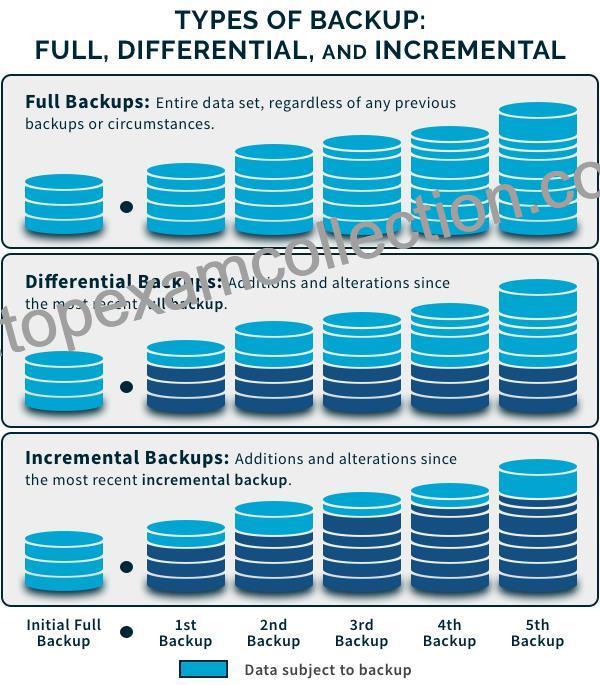QUESTION 121
A systems administrator is considering different backup solutions for the IT infrastructure. The company is looking for a solution that offers the fastest recovery time while also saving the most amount of storage used to maintain the backups. Which of the following recovery solutions would be the BEST option to meet these requirements?
Explanation
There are mainly three types of backup: full, differential, and incremental.
Let’s dive in to know more about the types of backup, the difference between them and which one would be the best fit for your business.
A basic graphic displaying the difference between full backup, differential backup, and incremental backup.

Full Backup
A full backup is the most complete type of backup where you clone all the selected data. This includes files, folders, SaaS applications, hard drives and more. The highlight of a full backup is the minimal time it requires to restore data. However, since as everything is backed up in one go, it takes longer to backup compared to other types of backup.
The other common issue with running full backups is that it overloads storage space. That’s why most businesses tend to run a full backup and occasionally follow it up with differential or incremental backup. This reduces the burden on the storage space, increasing backup speed.
Differential Backup
A differential backup straddles the line between a full and an incremental backup. This type of backup involves backing up data that was created or changed since the last full backup. To put it simply, a full backup is done initially, and then subsequent backups are run to include all the changes made to the files and folders.
It lets you restore data faster than full backup since it requires only two backup components: an initial full backup and the latest differential backup.
Let’s see how a differential backup works:
Day 1 – Schedule a full backup
Day 2 – Schedule a differential backup. It will cover all the changes that took place between Day 1 and Day 2 Day 3 – Schedule a differential backup. It will make a copy of all the data that has changed from Day
2 (this includes the full backup on Day 1 + differential backup) and Day 3.
Incremental Backup
The first backup in an incremental backup is a full backup. The succeeding backups will only store changes that were made to the previous backup. Businesses have more flexibility in spinning these types of backups as often as they want, with only the most recent changes stored.
Incremental backup requires space to store only the changes (increments), which allows for lightning-fast backups.
Difference Between Full, Differential and Incremental Backups
Full
Differential
Incremental
Storage Space
High
Medium to High
Low
Backup Speed
Slowest
Fast
Fastest
Restoration Speed
Fastest
Fast
Slowest
Media Required for Recovery
Most recent backup only
Most recent full backup & most recent differential backup
Most recent full backup & all incremental backups since full backup
Duplication
Stores a lot of duplicate files
Stores duplicate files
No duplicate files






